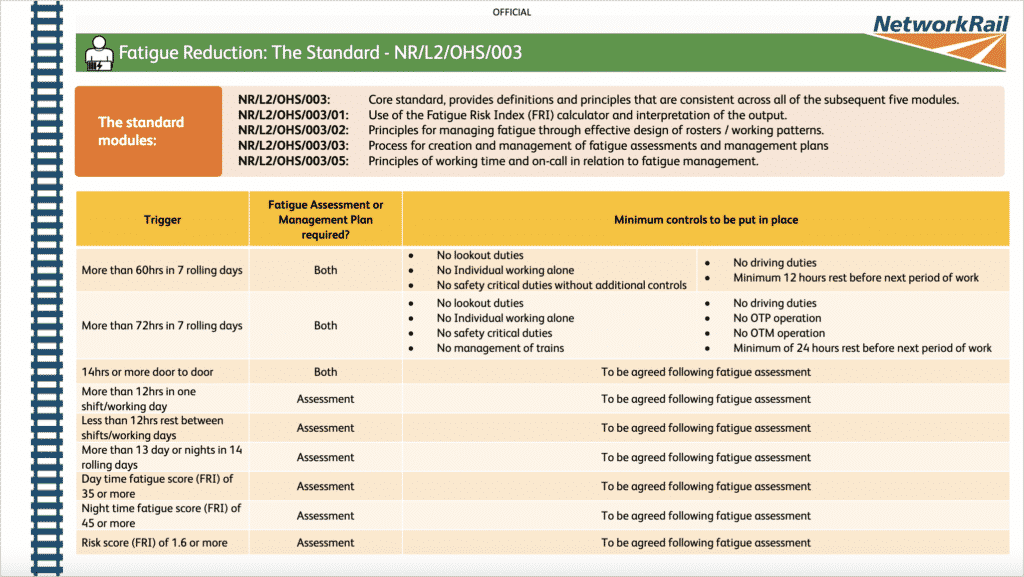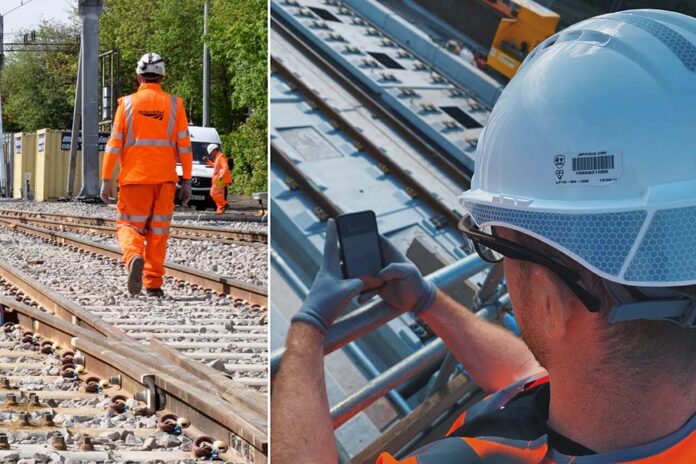Effective Fatigue Management has been a major issue in our industry for many years, with around 40% of accidents in the UK rail sector being attributed to workforce fatigue.
Network Rail has acted, with the new set of regulations NR/L2/OHS/003 coming into full force on 29th October 2022.
With this date fast approaching, contractors are starting to feel the pressure to revisit their strategy against workplace fatigue, as the new standard will directly impact more than 150,000 people across the sector. Radically changing how fatigue is managed.
What is workforce fatigue and why is it a problem?
Employers have a legal requirement to manage staff fatigue, and failure to do so can have disastrous consequences.
There is no single agreed definition of fatigue, but we will consider fatigue as “a state of perceived weariness that can result from prolonged working, heavy workload, insufficient rest and inadequate sleep” (ORR, 2012)
In fact, the effects of serious fatigue can be compared to being over the drink driving limit, causing poor judgements, slow reactions, poor memory, and impaired vision. In the rail industry, fatigue is the cause of 20% of high-risk incidents, and over the past five years the sector has experienced an average of 36 yearly worker fatalities (RIDDOR, 2016/17-2020/21).
3.1m people are employed as shift workers in the UK, and fatigue has been implicated in 20% of accidents costing the industry £115 — £240 million per year (an estimation based on the whole UK Construction Sector).
The numbers don’t lie:
- 54% of workers said they “feel overburdened at work”
- 37% of them have weekly shifts of over 50 hours
- 73% of workers think that fatigue is an overlooked hazard
- 65% think the industry is not doing enough to prevent such issue
(CC Scheme, 2019)
So what’s actually changing?
According to Network Rail, the previous standard only concerned the safety of critical workers while the new framework applies to everyone across the supply chain, and those working on NR infrastructure, systems and assets.
Instead of imposing limits on how much people can work, the new framework introduces “triggers” to signal the need for mitigating actions, such as mandatory rest periods and duties reallocation, including invigilation.
This new approach encourages companies to monitor fatigue and carry out risk management consistently, embedding a behavioural change in how we will tackle fatigue across the industry in the long-run.

How can I make sure I am managing fatigue effectively?
The innDex system has been specially designed and developed to fall in line with Network Rail Standards as well as being configurable to adapt to any other standards, prioritising workforce fatigue from the outset, before a worker even sets foot on site.
To manage fatigue, it’s important to be able to monitor workers’ hours and movements across every site that they work on. Using innDex, each worker will have their own profile – their construction passport. The innDex profile is submitted to a site before a worker even starts their first day, pre-enrolling and speeding up the induction process. This not only negates the need to carry out a laborious induction on site, improving productivity and eliminating frustration, but also allows every worker to be pre-briefed with important information and policies, familiarising with the project.
Once inducted, the innDex Fatigue Management tool allows managers to track workers’ site hours for real-time fatigue management, and enabling resource planning.
For years, fatigue management processes have fallen short, and companies have struggled to adequately manage fatigue with processes being very manual and working hours being assessed when it’s too late. With innDex, real-time automated notifications are sent out to managers and workers proactively. When Working Hours Policies are breached, a worker will be notified and can finish their shift and leave site safely or their responsible manager can carry out a risk assessment quickly through the innDex platform, which is stored as evidence against a worker’s breach.
Shift reports and historical data can be accessed on an individual or cumulative case basis when needed. By looking at raw data, the management team can perform deep data analysis and take evidence-based actions.
Now’s the time to be proactive, innovate and get ahead of the curve in Fatigue Management.
Click here to find out more about how innDex is being used to manage fatigue in line with the new Network Rail Standards and increasing efficiencies and savings across the supply chain.
Need help implementing a Fatigue Management strategy?
Get in touch at support@inndex.co.uk or by clicking on this link.



































 0113 2082620
0113 2082620 info@railbusinessdaily.com
info@railbusinessdaily.com 15 Mariner Court, Wakefield WF4 3FL
15 Mariner Court, Wakefield WF4 3FL

